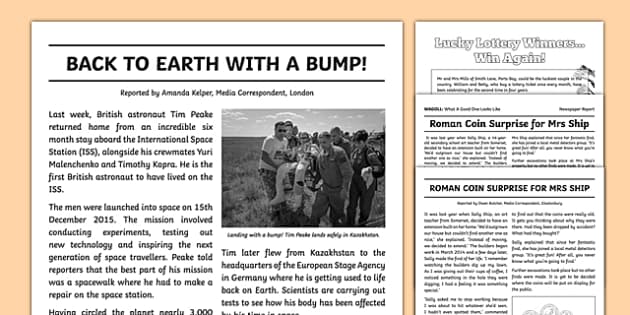News Articles Fundamentals Explained
News Articles Fundamentals Explained
Blog Article
The Ultimate Guide To News Articles
Table of ContentsThings about News ArticlesThe News Articles StatementsIndicators on News Articles You Should KnowNews Articles for DummiesRumored Buzz on News Articles
Good expertise of different topics provides pupils an one-upmanship over their peers. Even though electronic and social media are conveniently easily accessible, we should not neglect how vital it is to check out the papers. Parents must attempt and inculcate the behavior of checking out a newspaper as an everyday routine to continue the legacy of the revered print tool.News stories also contain at the very least one of the following important features relative to the desired target market: closeness, prominence, timeliness, human interest, oddity, or consequence.
Within these limits, information stories likewise aim to be detailed. Various other aspects are entailed, some stylistic and some obtained from the media type. Among the larger and more highly regarded newspapers, fairness and balance is a significant consider offering information. Commentary is usually confined to a separate section, though each paper may have a various total slant.
Newspapers with an international audience, for instance, often tend to use a much more formal design of creating. News Articles.; usual design guides consist of the and the United States News Design Book.
Little Known Questions About News Articles.
Generally, reporters will certainly not make use of a lengthy word when a brief one will certainly do. They make use of subject-verb-object construction and vibrant, energetic prose (see Grammar). They use stories, instances and allegories, and they hardly ever depend on generalizations or abstract ideas. News writers try to prevent utilizing the exact same word greater than once in a paragraph (in some cases called an "echo" or "word mirror").
Nonetheless, headings often omit the topic (e.g., "Leaps From Boat, Catches in Wheel") or verb (e.g., "Cat woman fortunate"). A subhead (also subhed, sub-headline, subheading, caption, deck or dek) can be either a subservient title under the primary headline, or the heading of a subsection of the write-up. It is a heading that comes before the primary text, or a team of paragraphs of the major message.

of a post subject, informant, or interviewee), it is described as a drawn quote or draw quote. Extra signboards of any one of these kinds might show up later in the short article (specifically on subsequent pages) to tempt further reading. Journalistic internet sites in some cases make use of computer animation techniques to swap one billboard for one more (e.g.
The Greatest Guide To News Articles
Such signboards are additionally made use of as pointers to the short article in other sections of the magazine or website, or as promotions for the item in other magazine or sites. Press launch of the Swiss government. Typical framework with title, lead paragraph (summary in strong), other paragraphs (information) and call info.

Instance of a hard-lead paragraph NASA is suggesting another room job. The budget demands roughly $10 billion for the task.
The NASA news came as the company requested $10 billion of appropriations for the project. An "off-lead" is the 2nd crucial front web page news of the day. The off-lead shows up either in the top left edge, or directly below the lead on the right. To "hide the lead" is to begin the write-up with background details or details of second importance to the viewers, forcing them to learn more deeply into an article than they must have to in order to uncover the vital factors.
An Unbiased View of News Articles
Common usage is that a person or more sentences each develop their very own paragraph. Reporters generally define the company or framework of an information tale as an upside down pyramid. The necessary and most intriguing elements of Get More Info a story are placed at the beginning, with sustaining info complying with in order of lessening value.
It allows individuals to discover a topic to only the deepness that their interest takes them, and without the imposition of information or nuances that they might consider unimportant, however still making that info available to more interested viewers. The upside down pyramid structure likewise enables short articles to be trimmed to any kind of approximate length during format, to suit the area offered.
Some writers begin their tales with the "1-2-3 lead", yet there are lots of type of lead offered. This format invariably begins with a "5 Ws" opening paragraph (as described over), adhered to by an indirect quote that offers to support a significant component of the first paragraph, and after that a straight quote to support the indirect quote. description [] A twist can refer to numerous points: The last tale in the news program; a "delighted" story to finish the show.
Longer write-ups, such as magazine cover posts and the pieces that lead the inside areas of a paper, are known as. Attribute stories differ from straight information in several methods.
The Single Strategy To Use For News Articles
A feature's first paragraphs commonly associate an intriguing minute or occasion, as in an "unscientific lead". From the details of an individual or episode, its sight quickly expands to generalities about the story's subject.

The Editor's Toolbox: A Referral Overview for Beginners and Professionals (2001) Allan M. Siegal and William G. Connolly. The New York City Times Handbook of Design and Usage: The Authorities Style Guide Used by the Writers and Editors of the Globe's The majority of Authoritative Paper (2002) M. L. Stein, Susan Paterno, and R.
Report this page